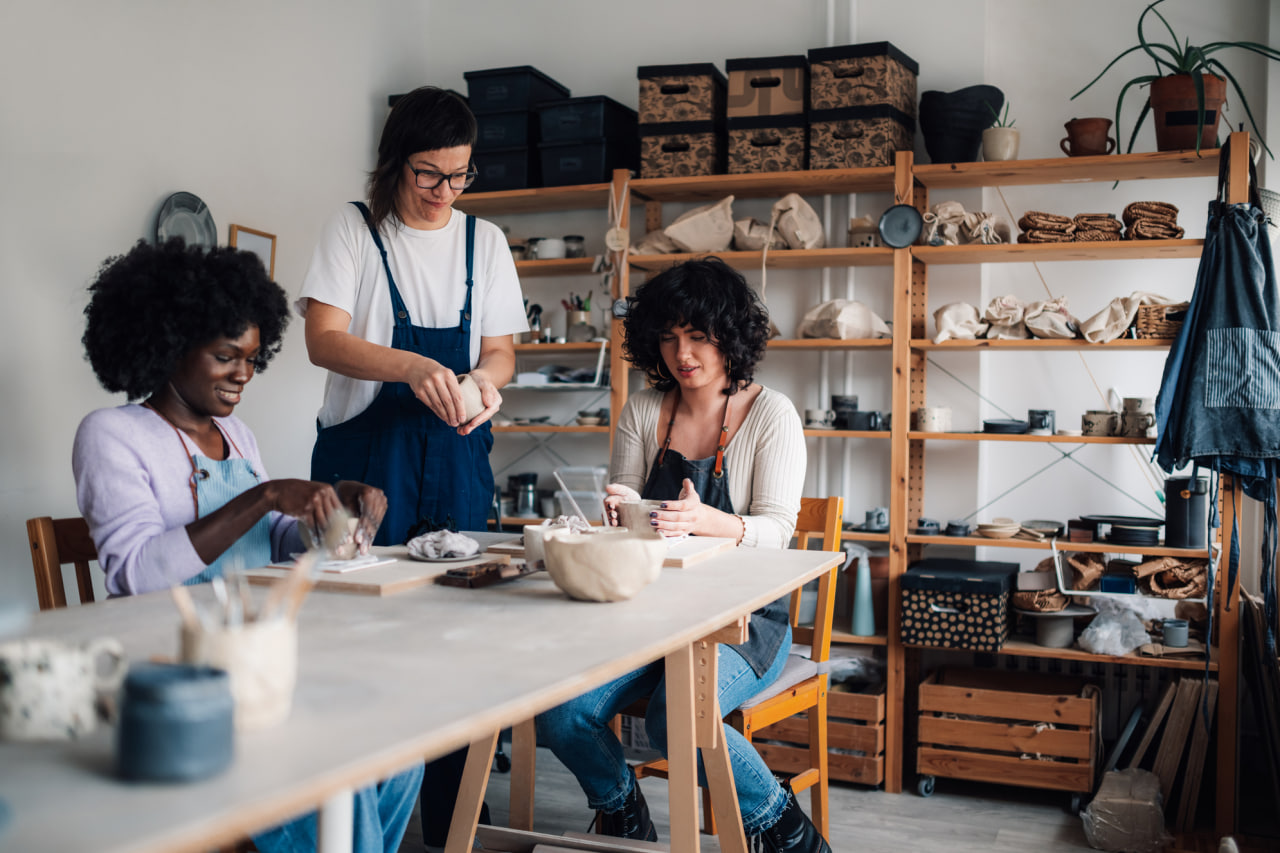When we think of ceramics, what often comes to mind are beautiful, colorful, and lustrous finishes that make a piece feel complete. But behind every dazzling ceramic piece, there’s a crucial step that elevates the piece from something functional into something truly artistic: glazing.
Glazing is an essential technique in ceramic art that not only enhances the appearance of the piece but also plays a pivotal role in its durability, functionality, and overall aesthetic. Whether you’re making functional pottery, sculptures, or decorative pieces, glazing is an art form in itself. It’s more than just a layer of color—it’s a transformative process that breathes life into clay.
In this blog, we’ll explore the importance of glazing in ceramic art, the different types of glazes, the glazing process, and why it’s one of the most exciting parts of working with ceramics.
What Is Glaze in Ceramics?
At its core, a glaze is a glass-like coating applied to ceramic pieces that fuses with the clay body when fired in a kiln. It’s not just for decoration—it serves multiple purposes, including sealing the porous surface of the clay, adding color and texture, and contributing to the overall visual appeal of the piece.
The glaze is made from a combination of minerals, oxides, and other materials that create a wide variety of finishes, from shiny to matte, transparent to opaque, and even textured. Glazes are usually applied in liquid form to bisque-fired pottery (clay that has been fired once to harden it but has not yet been glazed). After the glaze is applied, the piece is fired again at high temperatures, causing the glaze to melt and fuse with the clay body, resulting in a smooth, durable surface.
Why Glazing is Crucial in Ceramic Art
- Enhances Aesthetic Appeal
One of the primary reasons for glazing is to improve the visual appeal of ceramic pieces. The surface finish of the glaze can dramatically change the look of the piece, from adding vibrant colors to creating a glossy, metallic sheen. Glazing provides artists with an opportunity to explore a wide range of textures, colors, and effects, making it an essential tool in ceramic art.
Color and Surface Texture:
Glaze allows for infinite color possibilities. From rich, earthy tones to bright, bold colors, glazes provide artists with a palette of hues that can make a piece stand out. Textures can be added, as well, to create a tactile experience. Matte glazes offer a smooth, understated finish, while glossy glazes provide a reflective, high-shine effect. Glaze can also be used to create intricate patterns and visual depth.
Patterns and Layers:
Artists can experiment with layering different glazes, creating complex patterns, drips, and effects. For example, a glaze may be allowed to drip or pool in specific areas, adding a unique, organic touch. This allows for endless creative possibilities, making the glazing process both a science and an art.
- Seals the Ceramic Surface
One of the most important functional aspects of glazing is its ability to seal the porous surface of the ceramic. Clay is naturally porous, meaning it absorbs moisture, which can weaken the structure over time. Glazing forms a protective, impermeable barrier on the surface, preventing liquids from soaking into the piece and helping to maintain its integrity.
Durability and Functionality:
For functional pottery like mugs, bowls, and plates, glazing is essential to make these items water- and stain-resistant. Without a proper glaze, ceramics would absorb liquids and food, leading to bacteria growth and staining. Glaze also prevents ceramics from absorbing odors, making it a crucial component in any functional ceramic piece.
Prevents Leaching of Chemicals:
In the case of food-safe pottery, glazing is also important because it ensures that no harmful materials from the clay body leach into food or drinks. Certain clays contain trace amounts of minerals that could be harmful if ingested, but a well-fired glaze prevents any potential contamination by sealing the piece.
- Helps with Thermal Stability
Ceramics are often used to hold or contain heat—think of mugs, teapots, and oven-safe dishes. The glaze plays a role in making sure these pieces can handle thermal stress. When ceramics are heated and cooled, they expand and contract. A glaze with the right composition will not only add strength to the piece but also help it maintain its integrity when subjected to temperature changes.
Thermal Shock Resistance:
Glazing can also help mitigate thermal shock, which occurs when a piece is exposed to rapid changes in temperature. For instance, if a hot mug is placed on a cold countertop, the temperature shift could cause it to crack if the clay body and glaze don’t expand and contract at the same rate. By applying the right glaze, ceramic artists can improve the thermal shock resistance of their pieces.
- Protection Against Wear and Tear
Ceramics, especially those used for everyday purposes like dinnerware, are exposed to regular wear and tear. Glazing not only protects the piece from scratches, stains, and damage from water, but it also contributes to the overall longevity of the piece.
Long-lasting Beauty:
A well-applied glaze ensures that a ceramic piece will maintain its beauty over time. Glazed surfaces are easier to clean, resistant to staining, and able to withstand everyday use without showing signs of aging as quickly as unglazed ceramics might. For artists, this makes glazing an essential technique for creating durable pieces that can be cherished and used for years.
Different Types of Ceramics Glazes
The world of glazes is vast, and understanding the different types can open up new possibilities for your work. Here are a few common types of ceramic glazes you’ll encounter:
- Glossy Glaze:
A high-shine finish that gives ceramics a smooth, glass-like surface. Glossy glazes often highlight color and texture, giving pieces a vibrant, polished appearance. - Matte Glaze:
A non-reflective surface that offers a soft, subtle look. Matte glazes are often used to create understated pieces and can enhance the natural texture of the clay. - Satin Glaze:
Somewhere between matte and glossy, satin glazes provide a soft sheen that is not as shiny as a glossy glaze but still has a level of reflection. This type of glaze can add sophistication and elegance to ceramic pieces. - Celadon Glaze:
A translucent glaze often used for porcelain and stoneware. Celadon glazes are typically light green, but can also appear in shades of blue, yellow, or grey, depending on the iron content in the clay. - Raku Glaze:
Raku is a unique firing technique that produces distinctive glazes with cracked, sometimes metallic finishes. Raku glazes are often used for decorative pieces and are not typically food-safe. - Crackle Glaze:
This type of glaze creates a network of fine cracks on the surface of the piece. The cracks are purely aesthetic and can add an antique or weathered appearance.
The Glazing Process: Step-by-Step
The glazing process, while exciting, requires a good deal of patience and attention to detail. Here’s a basic overview of the steps involved:
- Bisque Firing:
Before applying the glaze, your ceramic piece must undergo a bisque firing, which turns the raw clay into a hardened, porous state. This provides a stable surface for the glaze to adhere to. - Choosing and Applying the Glaze:
Once your piece is bisque-fired, you can choose the glaze that best suits your design vision. Glaze can be applied in several ways: dipping, brushing, or spraying. Each method offers different effects and levels of control over the final outcome. - Glaze Firing:
After the glaze is applied, the piece is fired again at a high temperature in a kiln. This second firing allows the glaze to melt and fuse with the clay, creating the glass-like finish. - Cooling and Inspecting:
Once the firing is complete, the piece must cool slowly in the kiln to avoid cracking or thermal shock. After cooling, inspect the piece for any imperfections, such as glaze drips, uneven coverage, or cracks.

